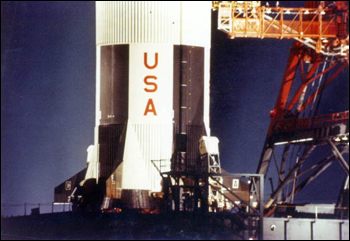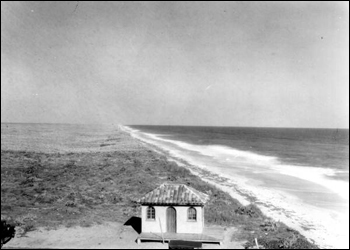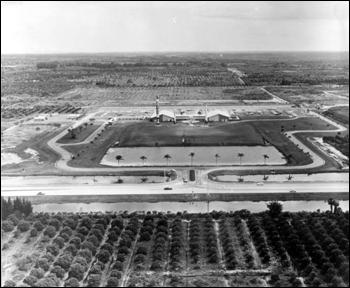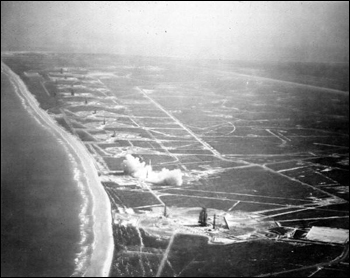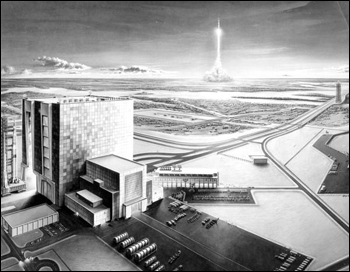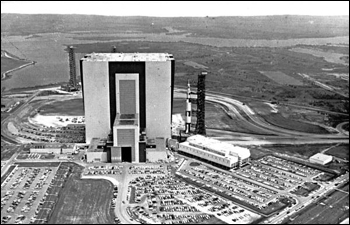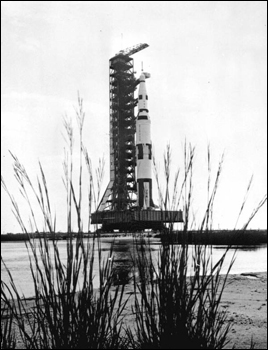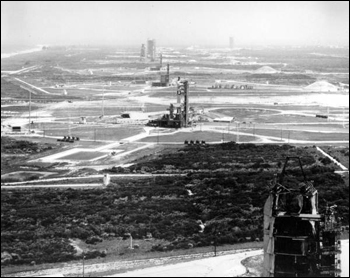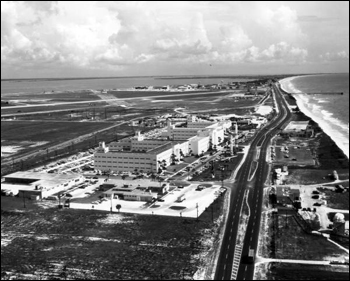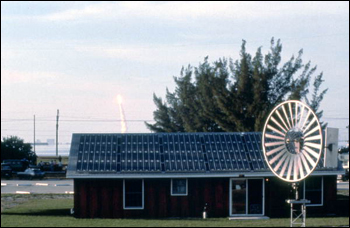Photo Exhibits
Photo exhibits spotlight various topics in Florida history, and are accompanied by brief text intended to place selected materials in historical context.
NASA Turns 50
Florida's Half Century on the Space Age Frontier
The Space Age Comes to Florida
Although Florida, the state of sunshine and beaches, swamps and alligators, was already home to Cold War-era missile sites, the dawn of the space age would bring dramatic changes to the state's economy, landscape, and culture.
Base of Apollo 11 (1969)
Image Number: PR10287
Looking north from the casino: Canova Beach, Brevard County, Florida (1929)
Image Number: GE1241b
Aerial view of Kennedy Space Center: Cape Canaveral, Florida (1969)
Image Number: C673795
Call to Action
October 2008 marked the 50th Anniversary of the National Aeronautics and Space Administration, better known as NASA. The launch of that program began the new American drive to take the lead in the world's study and exploration of space. With ambitious goals and a powerful sense of urgency, the United States took on its most profound challenge since World War II. As Americans began the work in pursuit of NASA's mission to "pioneer the future in space exploration, scientific discovery and aeronautics research," Florida and Floridians, old and new, found themselves once again entering a new age of discovery.
Row of intercontinental ballistic missiles: Cape Canaveral, Florida (19--)
Image Number: N040660
The photograph was taken at the Air Force Missile Test Center. The Air Force Missile Test Center later became the John F. Kennedy Space Center.
Artist concept of Saturn rocket takeoff (1963)
Image Number: PR10308
Apollo 4 exiting the vehicle assembly building: Cape Canaveral, Florida (1967)
Image Number: N041266
Apollo 4 pictured as it exits the vehicle assembly building and moves towards Launch Complex 39, Pad A. Apollo 4 was the first space vehicle in NASA's Apollo/Saturn V program. It was launched on November 9, 1967, using a Saturn V launch rocket.
Sputnik, 1957
After the Sputnik Flight of 1957, when the Soviet Union launched the first man-made satellite into space, pressure exploded from United States politicians and the American public demanding that the country catch up and increase investment in rocket technology and aeronautics. Anxiety over slipping to second in space exploration was fueled by the perceived implications of the command of space and rocket technology and its relationship with the nuclear arms race.
Talented Russian physicists and engineers, operating in the post-Stalin era under the direction of the more open and intellectually accepting premiership of Nikita Khrushchev, made rapid gains in rocket technology. The quick success of the Soviet space program surprised many American scientists and politicians who assumed that the Russians were dependent on imported, post-World War II German know-how, as the United States itself had been to some extent in the area of rocket engineering.
The launch of Sputnik and further Soviet successes, such as the launching of moon orbiters and solar system probes before the end of the decade, and the strong American national interest in space it helped spark, occurred just as rising Cold War tensions began to reach their most fevered pitch. The pressure to succeed and sense of urgency the United States government applied to space exploration was intertwined with the anxieties the nation felt during that period of strategic posturing and nuclear stand-off.
Apollo Saturn V space vehicle (1966)
Image Number: PR10170
A 365' tall Apollo Saturn V facilities vehicle is being moved toward the launch complex. This test vehicle (Apollo Saturn 500-F) was used to verify launch facilities, train launch crews and develop test and checkout procedures. A 3,000 ton crawler moved under the mobile launcher, lifting the launcher and the vehicle off its support pedestals. Combined weight of the launcher and space vehicle was almost 6,000 tons.
View of Gemini 5 launch vehicle (1965)
Image Number: PR10316
Building 989 Tech. Lab. looking north (1960)
Image Number: DOT0117
The "Missile Gap" and "A Man in Space"
The Sputnik launch dispelled notions that the Soviet Union was progressing more slowly than their American counterparts and provided vivid evidence, beeping and blinking across the American night sky, that the United States would have to rededicate itself in order to lead the world into space with a new national mission, placing more emphasis on science in schools and through broad national policy. In order to launch satellites, achieve manned space flight, and explore space the United States would have to rapidly increase the development of training and manufacturing facilities, as well as foster its own flowering of advanced science and math study and resurgence of technological innovation.
Texas Senator Lyndon Johnson was a key congressional leader supporting greater American space-age development. Johnson very quickly made himself an expert on aeronautics development and became one of the strongest advocates for the establishment of a full-scale national effort to get Americans in space.
Johnson pushed the Aeronautics and Space Act through the congress in 1958. After President Dwight D. Eisenhower established the National Aeronautics and Space Administration (NASA), October 1, 1958, Johnson, under the president's direction, spearheaded the "man in space project."
With this initiative, the United States would catch up to the Soviet Union and regain world leadership in the space race. A newly energized space program would also help address the growing, however mistaken, public belief that the Soviet Union was outpacing the United States in the production of new, nuclear-capable inter-continental ballistic missiles (ICBMs), what would come to be known by the end of the 1960 U.S. elections as closing the "missile gap."
View of space shuttle launch behind renewable energy technologies of the Florida Solar Energy Center: Cape Canaveral, Florida (not before 1981)
Image Number: DL0773

 Listen: The Bluegrass & Old-Time Program
Listen: The Bluegrass & Old-Time Program